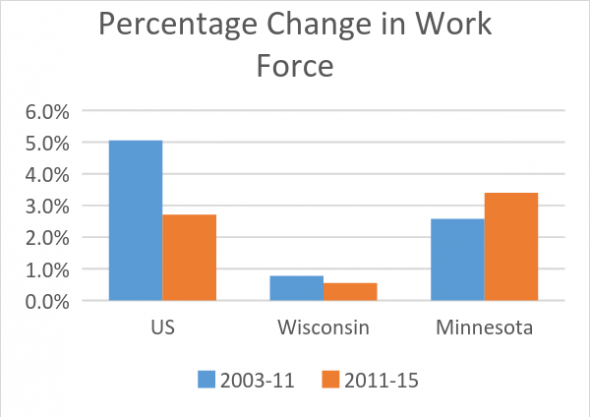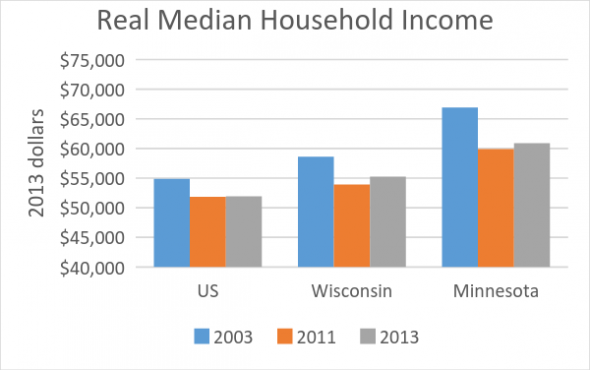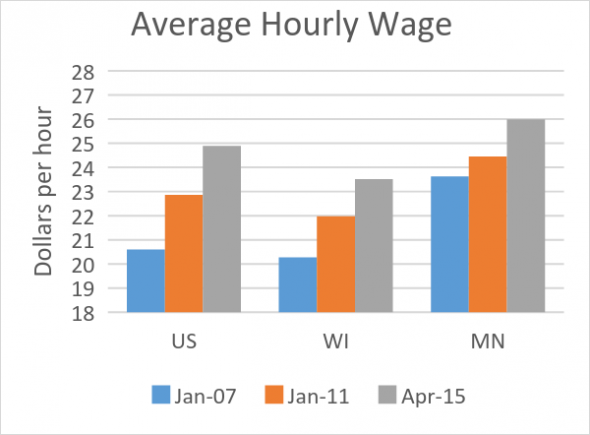Why Is Minnesota Outperforming Wisconsin?
Does having a Republican or Democratic governor explain the difference?
Recently President Barack Obama gave a speech in Wisconsin jabbing Gov. Scott Walker by noting how much better Minnesota’s economy is doing, which brought objections from Walker’s supporters. There’s no question that Minnesota has outperformed Wisconsin’s during the past five years. The question is why. Does a comparison between the two neighbors actually tell us anything about the relative effectiveness of the Democratic and Republican parties’ economic policies?
Let’s start by looking at the two states’ major measures of economic performance between 2003 and 2011. Between 2003 and 2011, Wisconsin’s governor was a Democrat and Minnesota was a Republican. In 2011, party affiliation flipped: Wisconsin elected Walker while Minnesota elected Democrat Mark Dayton. (Where available, the numbers used here start in January 2003 and end this spring. In some cases, the period covered is shorter, either because of delays in publishing recent numbers or because a series started after 2003.)
Employment
The job numbers have received the most attention, in part because Walker made jobs a centerpiece of his first campaign, promising to create 250,000 new private sector jobs. The first graph shows the percent change in jobs in the two states and the US both before 2011 and since then.
Given that the earlier period (graphed in blue) includes the economic collapse of 2008, it’s not surprising Wisconsin and nation both saw jobs decline (Minnesota had zero change during that period, with no decline or growth in jobs). In the years since then, 2011-2015, the economy was rebuilding, but both Minnesota and the nation led Wisconsin in gaining jobs.
Unemployment
Boasting that Wisconsin’s unemployment rate is below the national average, Walker neglects to mention that it was already lower when he took office. Minnesota’s rate started lower than Wisconsin’s and has continued to decline since.
The unemployment rate is a double-edged statistic: its decline can either reflect good news or bad news. It is good news if the decline reflects formerly unemployed people finding jobs. However, there are other ways the unemployment rate can decline. One is that unemployed people get discouraged and stop looking for a job. Another is that they leave a state looking for a job. Either of these will result in a decline in the work force.
The next chart shows the percentage change in the work force in Wisconsin, Minnesota, and the US. Wisconsin’s small increase compared to nationally and in Minnesota suggests the decline in unemployment may largely stem from unemployed people leaving the Wisconsin work force as opposed to finding jobs.
The Walker administration is often guilty of spinning bad news into good news. For example, the headline on the press release for April jobs numbers said: “State Unemployment Rate Declines to 4.4%, New Post-Recession Low.” This sounds like good news. However, it actually stemmed from two pieces of bad news. Both the size of labor force and the number of people employed were down. Because the labor force declined more than the number of people employed, the unemployment rate went down. (In May’s report it jumped back up to 4.6 percent.)
Wages and Earnings
The next plot shows real median household income in Wisconsin, Minnesota, and the US, for 2003, 2011, and 2013, the last year for which figures are available. Minnesota households are doing considerably better than those in Wisconsin, who in turn slightly exceed the national average. Minnesota households consistently earn more than those in Wisconsin or nationally, but everyone is down compared to before the recession.
The next plot shows average wages (this data series started in 2007). At first blush, it contradicts the data on household incomes. Even during the recession, average wages rose. Perhaps this reflects that during a recession the low-wage, low-skilled workers were the first to be laid off, leading to a rise in the average wage.
When it comes to wages, In contrast to household income, Wisconsin lags not only Minnesota but the national average.
What can we conclude from these comparisons?
First, it is important to caution that comparisons between states are fraught with difficulty. States differ in numerous ways and it extremely difficult to isolate a single cause. These difficulties are compounded with a sample size of two.
Second, it seems clear that Minnesota has managed to develop a more resilient economy than Wisconsin. In every measure it out-performed Wisconsin both during the recession and since. The reasons for these differences are worth serious discussion.
Third, the data offer no support for conservative insistence that Walker’s policies have improved the Wisconsin economy or that Dayton’s, including raising taxes and increasing the minimum wage, have hurt Minnesota’s. By the same token, the data suggest caution for those over-enthusiastic liberal organizations hoping to use the two states to prove the superiority of their preferred policies.
Yet if the economic benefits of the Walker strategy are, at best, undemonstrated, the costs are not. The costs include less environmental protection, lower funding for education at all levels, lower wages and benefits for Wisconsin workers, and a more regressive state tax and spending system at a time when there is growing concern about economic inequality. A policy with demonstrable costs but unproven benefits strikes me as a bad deal.
Underlying the Wisconsin-Minnesota comparison is the question of how much government—embodied by people like governors or policies like right-to-work–are responsible for economic results. While advocates on both sides play the government-centric card when it fits their interests, the idea that government policies explain everything has taken particular hold on the right. We see this in claims that Democrat Jim Doyle was responsible for Wisconsin’s lagging economic performance during the boom years before the recession and in Walker’s promise to create 250,000 jobs in his first term. This government-centric viewpoint underlay the bogus claims that a right-to-work law would create more jobs, based on the difference between states with and without such laws.
In Wisconsin, no organization has more enthusiastically supported the government-centric viewpoint than Wisconsin Manufacturers and Commerce. It promised that adoption of its program—including relaxing environmental regulations, adopting a right to work law, eliminating taxes on manufacturers, and cutting taxes and spending—would bring prosperity and jobs.
To support his argument, Bauer refers to a March Atlantic Magazine article, The Miracle of Minneapolis: No other place mixes affordability, opportunity, and wealth so well. What’s its secret? by Derek Thompson. He neglects, however, to mention Thompson’s answer to this question: “the answers appear to involve a highly unusual approach to regional governance, one that encourages high-income communities to share not only their tax revenues but also their real estate with the lower and middle classes.”
Rather than learn anything from the divergent state performance, Bauer insists that with time the Walker policies will be vindicated: “any history professor worth his or her salt will tell you it is far too early in Walker’s tenure to determine how his pro-business reforms have impacted Wisconsin’s long-term economic competitiveness.” He insists Walker’s “better Wisconsin business climate will lead to a better Wisconsin economy” and that “the opposite is true for Minnesota” because of policies implemented by Gov. Dayton.
Empirical evidence can lead to better solutions—but not if it is treated only as grist for a pre-determined position.
Data Wonk
-
Scott Walker’s Misleading Use of Job Data
 Apr 3rd, 2024 by Bruce Thompson
Apr 3rd, 2024 by Bruce Thompson
-
How Partisan Divide on Education Hurts State
 Mar 27th, 2024 by Bruce Thompson
Mar 27th, 2024 by Bruce Thompson
-
Will Wisconsin Supreme Court Legalize Absentee Ballot Boxes?
 Mar 20th, 2024 by Bruce Thompson
Mar 20th, 2024 by Bruce Thompson




















So rabidly pro-Walker WMC’s message is “sure Minnesota is better now but trust us someday not sure when but someday Wisconsin will be better.” That’s really convincing.
We haven’t outperformed Minnesota since the 90’s……. the 1890’s. We have and continue to invest in postindustrial economy and Minnesota is vested in the “new” economy. Minnesota invests in and values its center of culture and commerce, the Twin Cities, we vilify Milwaukee and Madison. The Twin Cities are supported regionally, the Milwaukee area is divided. We are divided by race and Minnesota is united in its whiteness. Minnesota invests in quality of life initiatives, we want to eliminate sidewalks and bike paths!!! Minnesota invests in transportation improvements, we make anything other that cars and freeways illegal. Minnesota invests in it’s cultural amenities, we starve ours. Minnesota has a progressive governor, we have Charlie Sykes. Minnesota is working to make the U of M better, we want to destroy ours because they teach evolution.
We should change our state motto from “Forward” to “Divide and Conquer”. Our politicians have turned us against each other. Did you know teachers are the cause of all our problems?!? I had no idea, but I’m glad we figured that out.
If I’m a 23 year old grad, why would I ever pick Wisconsin over Minnesota? I ask this because I love Milwaukee and Wisconsin. I think its mostly cultural, and the Tea Party is a big step backwards.
Speaking of Income Inequality, spurred by comments suggesting Walker’s WI is among the most equal over at JSOnline, I ran the pre- and post-Walker inequality stats (Gini Coefficient, Table B19083 at http://factfinder.census.gov).
Walker inherited a state with a 2010 Gini of .430 which did, indeed rank WI 6th for most equal distribution of wealth. However, by 2013, the most recent year for which the indicator is available, WI had sunk to 10th in the rankings with a Gini score of .445. Furthermore, the magnitude of WI’s drop ranked it as the 11th largest increase in inequality.
Minnesota, on the other hand, started that period ranked 13th most equitable with a Gini of .440, and by 2013 had crept UP to 11th with a G-score of .446. That represents the 40th ranking in magnitude of inequality increase, or more intuitively, MN had the 10 smallest increase in income inequality.
It’s important to keep in mind that inequality increased in ALL states but two, Wyoming and Alaska, which interestingly comprised 2 of the 3 top spots for most equitable states initially. It’s likely that a fix for economic fairness will need to originate at the federal level.
Why do you people continue to compare Minnesota to Wisconsin? What the hell does Minnesota have to do with anything here? Wisconsin is a manufacturing and Rust Belt state that has struggled making the transition to the 21st century economy. I’m dying to know where all those pre-Walker UW-System Jedis are and why they choose to move/invest elsewhere. Milwaukee sure as hell wasn’t the Twin Cities before 2011 now was it?
Walker has nothing to do with any of this, it is a bi-partisan problem. We are a divided state. Minnesota has the benefit of being dominated by one large, wealthy, educated metro area. We don’t. The end.
Great analysis, Bruce. And a fascinating point made in the final sentence below:
“To support his argument, Bauer refers to a March Atlantic Magazine article, The Miracle of Minneapolis: No other place mixes affordability, opportunity, and wealth so well. What’s its secret? by Derek Thompson. He neglects, however, to mention Thompson’s answer to this question: “the answers appear to involve a highly unusual approach to regional governance, one that encourages high-income communities to share not only their tax revenues but also their real estate with the lower and middle classes.”
This issue of the need for regional solutions and even state involvement in urban issues was raised by UWM historian Joseph Rodriquez in his recent book: “Bootstrap New Urbanism: Design, Race & Redevelopment in Milwaukee.” He says these problems were not all created by the cities themselves and won’t be solved by forcing cities to completely pull themselves up by their bootstraps. Nonetheless, he sells Milwaukee excels at self-help efforts. We have some of the highest volunteerism rates in the country. Volunteers build parks and boost tourism with all our ethnic festivals.
To build on David’s comments, both Minneapolis and St. Paul are tied as #1 best cities for parks by The Trust for Public Land in their annual Park Score. Milwaukee is #22, a ranking perhaps boosted by the number of park acres we’ve inherited, even if they are neglected. MPLS spends about $200 per person per year on parks. Milwaukee (city) spends $93.
Rodriquez notes that the mere presence of those parks, even if rundown, has boosted redevelopment in the city because parks are so beneficial in building community and promoting livability.
We need vision and commitment to the greater good to make needed changes on fundamental levels.
For another article, consider analyzing the correlation between a city’s “single, with children” percentage and almost any economic indicator. Same for a city’s “married, no children” percentage.
I grew up in Minnesota, it is completely different state. Of German, Norwegian, Swedish nature very few minorities and very hard working tending socialist people. Small cities only twin cities is big. They got into lots of Tech, big farm state, while Milwaukee was big in heavy industries. We are more like Ill.
Minnesota did not have a bunch of worthless lefties like the Doyle and Barrett gangs. They are more like the old dems from 50’s.
Minnesota is doing better because they have more German, Norwegian, and Swedish people? What are old Dems from the 1950s like? Racist?
And very few minorities? Minnesota and Wisconsin have extremely similar demographics. http://www.indexmundi.com/facts/united-states/quick-facts/compare/wisconsin.minnesota
You don’t make much sense WCD.
Minnesota and Wisconsin do have very similar demographics and similar size populations. Of nearby states, it’s probably the most reasonable comparison for Wisconsin. However, I don’t think we can draw a whole lot of conclusions from current economic conditions and attach blame or credit to Dayton and Walker. In my opinion it’s unreasonable for the left to say that Minnesota is obviously doing better economically because of Dayton’s left-leaning policies. It’s also unreasonable for the right to say that without Walker’s right-leaning policies Wisconsin would be doing worse economically.
I do think one could note that Minnesota’s economy has not been significantly harmed economically by liberal policies and that Wisconsin’s economy has not jumped ahead of Minnesota because of our conservative policies.
Thanks Bruce Thompson for so succinctly debunking Bauer’s attempt to continue and promote the lies that Scott Walker has been good economically for Wisconsin and that his well laid plans will be beneficial in some distant future.
The difference is our post-industrial economy vs their new economy and the culture differences that are a result of our economies. Milwaukee is a classic post-industrial city. Much larger and poorer African American population and much less educational attainment across the board. We are separated from the suburbs in every way. The “Iron Ring” is as strong as ever. Mpls is more like Madison and we are more like Cleveland. I don’t think Walker has much to do with our state economy good or bad. My issue is the incredible division and bipartisan fighting.
People in the burbs listen to talk radio for their marching orders like lonely housewives flock to Oprah. We all know WCD is just a foot soldier but he’s not alone. My friends in lake Country hate Milwaukee but when pressed they’re not really sure why. Its divide and conquer. That is the worst thing Walker and his dark army could have done. We need to build each other up. We all ultimately want the same thing.
Demographics of Wisconsin and Mn are entirely different In growing up and working in Rochester, Winona, Mankato, LeSeuer, Fairmont and visiting Twin cities all the time I seldom saw any Blacks no Hsipanics. some Asian. Black population has grown the last decade cause of jobs, but you simply do not find inner cities anywhere in Mn., like you do in Madison, Racine, Kenosha, Green Bay. The people are very industrious. Farming communities are huge. Mn was blessed in that they do not have a worthless Mayor or governor that drives out businesses. You never hear the stupid propaganda like tax the rich, kill the 1%ers etc in Mn.
Because you seldom saw minorities does not change facts WCD. Do you understand that? Demographically Minnesota and Wisconsin are nearly identical. Your personal experience does not change that.
And again you have no idea what you’re talking about. You just make stuff up. Minnesota’s governor literally taxed the rich. He turned the propaganda into reality. http://www.huffingtonpost.com/carl-gibson/mark-dayton-minnesota-economy_b_6737786.html
PMD, lets be fair when we discuss demographics and how they evolved in the two states, especially in their major metro areas. The African American community swelled in Milwaukee sooner than the twin cities, and in greater proportional numbers during the industrial boom times. Those times also hit Milwaukee harder when they busted and many manufacturing jobs went overseas. The numbers of minorities in the twin cities at the time and the socio economic impacts were at very different levels and the effects of those impacts can still be felt today.
It is difficult to compare the situation in the Twin Cities with those in Milwaukee. Not that the TC don’t have challenges of their own, especially with the large number of minority immigrants… but that only further proves the difficulty in comparing the two.
So WCD, to understand your comment (outside the silly “black people don’t exist in Minnesota and therefore they have a better economy for some reason” talking point) in Milwaukee, you build a streetcar or light rail or want to raise taxes to pay for infrastructure and it’s anti-business. In the Twin Cities, you do that and you’re not? You claim their governor and mayor are not trying to push businesses out, yet they push hyper-progressive policies (the same ones Barrett and Soglin push).
I’m starting to think you’re a parody account trying to make conservatives look silly cause you’re arguing a Schrodinger’s Cat of economic policy where progressiveness is both good and bad for economic growth at the same time depending on the state.
Are we comparing the Twin Cities and Milwaukee, or Minnesota and Wisconsin? And really the main point I wanted to make is that WMC’s defense of Walker and the state’s economy is pretty flimsy at best.
That’s what I was trying to get at Beer Baron, but you said it better. And he could be a plant, just like Donald Trump is a plant.
I think it’s hard not to have the conversation focus a great deal on the two major Metro’s that anchor the States since they have such a large relative impact, especially in MN where a greater portion of their state lives in the metro.
Lets not confuse my statements with actually agreeing with WCD… even when I agree with him I tend to disagree with him. If that makes sense!
But he’s not making any sense here AG. He’s saying Minnesota and its politicians didn’t do the exact things that they actually did.
And even if he didn’t see many minorities back when he was in Minnesota, whenever that was, it’s hardly proof of a lack of minorities in the entire state. I could go to a bunch of Wisconsin cities right now and declare “hey there are very few minorities in Wisconsin!” Doesn’t make it so.
Yeah I’m in no way defending any comments by WCD, I just skip past his posts. I was only mentioning that because you mentioned similar demographics between the states… which was too simplistic of a comparison.
I only meant that as of today the demographics are very similar. Isn’t that true?
I lived in St. Paul for six years – yes, MN has plenty of minority groups. Blacks, Hispanics, Somalis, Hmong, and many others exist in numbers very similar to WI.
WCD: “Rochester, Winona, Mankato, LeSeuer, Fairmont and visiting Twin cities”
Switch those cities with Appleton, Wausau, Eau Claire, Lacrosse, Spooner and visiting Milwaukee – I bet outside of Milwaukee you won’t see many minorities in WI either, and depending on where in Milwaukee you go you may think there’s nothing but white people anywhere in this state.
WCD: “you simply do not find inner cities anywhere in Mn”
Ever been to North Minneapolis? East Side of Saint Paul? Columbia Heights? Brooklyn Center? Sure, no inner cities anywhere. And the fact that you mention Madison’s “inner city” is laughable.
Also look up RT Rybak, former mayor of Minneapolis – he probably won’t be welcomed into the Republican Party any time soon, but Minneapolis has definitely been on the upswing during and since his 3 terms in office.
At the end of the day, neither side can point to their party or candidate and say that policy X or Y has created all the wonderful things they want us to believe. There’s too many moving pieces beyond the control of a mayor, governor, legislature, etc., and the pieces they can control are usually much longer term trends than they want you to believe. MN was never the manufacturing powerhouse that Milwaukee was; so I’d venture that the Rust Belt impacts hit them much less than they hit WI. However, MN has for a long time invested in public education where WI has since the Thompson administration tried to find ways to cut education investments. Draw your own conclusions.
Any idiot can lookup demographics and Mn. has only about 5%, if you bother. Some in Twin Cites but lower areas there, are nothing like we have. The difference is that they have better, smarter leaders, Leftwing or not. They do not have Barrett, Dimitrjevic or Doyle, totally worthless leaders.All the Left does is have opinions, no facts. It take two seconds to check demographics.
Indeed it does only take two seconds to look up the demographics. Here they are:
Resident population: White alone, percent, 2010 86.2% (Wisconsin) 85.3% (Minnesota)
Imagine that! Almost exactly the same. What were you saying about idiots now?
Bob, best to quit while you’re behind.
The demographics between Minnesota and Wisconsin as a whole are similar in terms of minorities and population. The demographics between the Twin Cities and Milwaukee are a bit different though, at least according to the 2010 census:
http://censusviewer.com/city/WI/Milwaukee/2010
http://censusviewer.com/city/MN/Minneapolis/2010
http://censusviewer.com/city/MN/St.%20Paul/2010
Per the 2010 census data above, Milwaukee was about 55% minority while the Twin Cities were 40%. Since the Twin Cities are larger than Milwaukee, the minority demographic percentages don’t have to be as high for the demographics of the whole states to even out.
With that said, I think there are plenty of other differences between the Twin Cities and Milwaukee, and Minnesota and Wisconsin, other than demographics that explain their current trajectories. History, regional cooperation, geographic location and the relative sizes of the metropolitan hubs compared to their states all come to mind.
Wikipedia had graphs: 5% Black, 4 Asian, all productive, most of Black population, cause it is so small and spread are productive the rest are Large native and scattered races, all productive. no Hispanic listed.
Minnesotsa does not hve the nutty Leftists that Milwaukee, racine and Madison has. they are more closely tied to the 50/60’s dems. Productive.
So the governor of Minnesota is not a “nutty leftist” for raising taxes on the rich?
Yeah Bob….. time to move on. The difference I believe (I lived and went to college in the Twin Cities) is that they have a very unified region. They understand the value of the two cities. We are very divided here. The Twin Cities region shares in revenue and for the most part has a unified vision. I don’t believe Scott Walker is necessarily bad for our economy but he runs on a platform of division, which is exactly what we don’t need and WCD carries his water.
Just to show difference. Minneapolis had 39 murders last year, less than half of what we had all last year and less than half of what we have this year. In the small towns murder and aggravated assaults are practically non existent. My Grandfather was dep. Sheriff and my great Uncle, sheriff in Mankato. Our family grew up just around corner from Ron Johnson. Biggest crime they ever had was chasing bootleggers .
Gov. and Mayor are cognizant of public safety and did not wreck the economy, as did Doyle, putting us all into the hole for decade.
WE do not carry anyone’s water, the last 50 years, but have banged on numerous projects of Scott’s, starting with the arena project.
Minnesota
83.1% white
5.4% black
4.7% Hispanic
4.0% Asian
Wisconsin
83.3% white
6.3% black
5.9% Hispanic
2.3% Asian
I’m puzzled by the claims that Minnesota did not have any “nutty” leftists. Minnesota does, in fact, have a tradition of electing liberal politicians. However, maybe they cannot be called “nutty.” Hubert Humphrey, Walter Mondale, Congressman (and later Mayor) Don Fraser, the late Paul Wellstone, Al Franken, Amy Klochubar, Keith Ellison and the late Congressman Jim Oberstar.
WCD: Wikipedia, while useful, is not a great website for checking facts. It is often incomplete or slanted depending on who last edited a page. If an ethnicity is not included in some demographic there, it might just be wrong. The Census pages are better, especially if you know how to drill down through the selection process and export an Excel compatible file for analysis.
Cities and states develop personalities and ethics. While MN & Wis. may share some traits, Greater MKE dug in its heels on policies that supported suburbs while keeping city dwellers from getting to jobs there, etc. Now MKE is doing an OK job of drawing residents, businesses and visitors back to the city. But no one talks about addressing problems as a county, much less a region. Only focus is on attracting millennials and baby boomers. The middle class is viewed as chopped liver and the rest are ignored.
Here’s one big diff: Everyone interviewed about sports venues in MPLS told JS’s Daykin that MKE should set aside land for parks as part of arena, not just concrete plazas courtyards of sports bars. Instead we will give the Bucks 30 acres of public land and hope they’ll toss us a bone–a “public space” on some land that’s worthless for anything else. That’s because the Twin Cities value parks and MKE officials do not. Most citizens value them but calls for park sales are now common here–our town plaza is only valued for redevelopment. Folks in MN tell me they cannot even fathom that attitude.
Chris Abele is so clueless and politically dense that he wants to back-stab the art museum, despite being a big donor, and sell the park that is their front yard and provides most of their parking. Selling O’Donnell has become his obsession, though now his new mission is dunning debtors to pay for the arena (rather than admitting it all comes from the same pot. MKE needs some visionary leadership, not cronyism and pleasing the richest guys in any room. Change will come, but not led by those now in power.
Our region is too divided. M…. we have 14,000 acres of parkland in the county yet we starve them of resources. We have no dedicated funding for parks, transit, zoo, museum, etc. Political and social division is a hobby in these parts. It’s a business that allows talk radio hosts to drive public policy and get wealthy at the same time. MPLS and St. Paul have spent billions on new arenas and stadiums, while also outspending us on their parks system and the arts. No one is calling for the mass selling of our parks with the exception of O’Donnell. Oh…. and the beer gardens…… which get white people to use the parks.